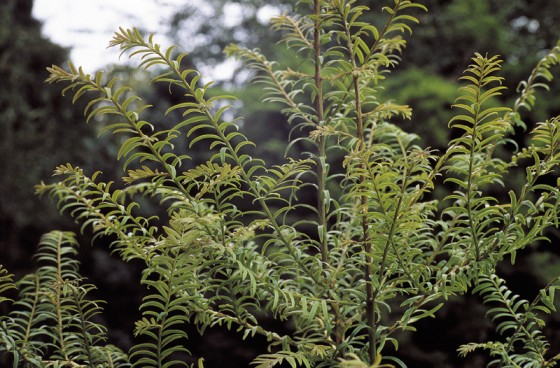Taxus species, commonly known as Yew trees, are found in most of Europe, Asia, North Africa, and Iran, as well as parts of North America. Once thought to consist of one species (Taxus baccata) with many subspecies, there is continued debate on the number of species included in this genus.
Yews are ancient trees which take their time to reach maturity. They can live for thousands of years; the oldest known individual is found in Perthshire Scotland and is estimated to be about 5,000 years old.
Yews have a rich mythological history. Throughout Britain and Ireland, yews are found in churchyards where they are often older than the buildings themselves. The ancient Celts believed that yews were a symbol of resurrection and trees were planted on the graves of their dead.
In later years, Christian churches were built on top of Celtic sites of worship where the yews were planted. Another theory suggests that yew trees were grown in churchyards, previously the only walled areas, to keep the poisonous trees away from livestock.
Yew trees were also a popular material for crafting bows, as the wood is both strong and elastic, This added pressure exhausted yew forests during times of conflict and when hunting was the method of food collection. A spear made from yew found in Essex, UK, was estimated to be 200,000 years old and is the oldest wooden artifact in the world.

Taxus yunnanensis photographed at Westonbirt arboretum, UK.
In the mid 1960s a poisonous alkaloid, taxane, was found in the bark of the Pacific yew, Taxus brevifolia (Near Threatened). Taxane has since been developed into a cancer-fighting drug called taxol - and different species of yew have now been found to contain cancer-fighting compounds in different forms.
Harvesting bark kills the tree and over-exploitation has led to some Taxus species becoming threatened with extinction. Five Taxus species are currently listed under Appendix II of CITES, limiting their trade to material sourced from plantations only. These include;
- The Chinese Yew, T. chinensis (Endangered). It has undergone a population reduction of more than 50% since the 1990s as a result of the discovery of the importance of this species for treating cancer.
- The West Himalayan Yew, T. contorta (Endangered). It has undergone a population decline of at least 50% due to over-exploitation associated with Taxol production, amplified by heavy logging.
Harvesting must be well managed and sustainable to ensure it does not further threaten wild populations of Taxus species. Extraction methods that do not kill the species and harvesting from cultivated rather than wild populations are essential conservation measures. For example;
- The leaves of the more common European Yew, T. baccata (Least Concern), contain compounds that can synthesise cancer treating agents.
- The more common Canada Yew, T. canadensis (Least Concern) is also being successfully harvested in northern Ontario, Québec and New Brunswick, and has become another major source of taxol.
Leaf colour and shape differ between species, however all yews are evergreen retaining their leaves during winter. Japanese and European yews both have dark green leaves, with the latter having red fruits. Florida, Mexican and Pacific yews are more distinct but are very rare.
Please note: The IUCN conservation status illustrated here does not apply to all Taxus species. A total of 10 Taxus species have been assessed on the IUCN Red List and their conservation status ranges from LC to CR, with EN being the most common status. Natural range also varies per species. For individual Taxus species assessments please check the IUCN Red List.
Did you know?
Taxus contorta populations have declined by at least 50% due to overexploitation associated with medicinal use.
